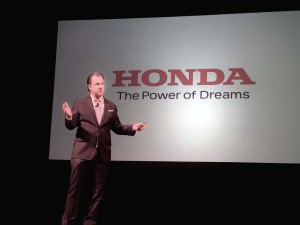When Henio Arcangeli came to Detroit this week he might have stopped by the offices of Detroit’s Big Three to offer his thanks. As the senior vice president of the automobile division of American Honda Motor Co., Arcangeli is setting out to pick up some of the business General Motors, Ford and Fiat Chrysler are giving up as they slash their passenger car line-ups.
It’s not that Honda is determined to ignore the rapid shift that has seen sales of SUVs, CUVs, pickups and other light trucks surge to 70% of the American new vehicle market so far this year, it’s just that the Japanese automaker thinks it can continue to grow demand for familiar sedans and coupes, like the Accord and Civic, while also adding more trucks to its own model mix.
“We all know the narrative: Cars are dead and dying,” Arcangeli said Friday during a lunchtime presentation to the Automotive Press Association. “That’s certainly true for some, but not for us. Our story is a little different.”
Honda has an almost even split, its passenger car line still accounting for 47.5% of its U.S. sales, with trucks like the HR-V, CR-V and Pilot making up the remaining 52.5%.
(Honda offering optional camera sideview mirrors on e urban crossover. Click Here for the story.)
The executive’s comments underscored what has become a sharp debate in automotive circles, especially when it comes to the Detroit automakers. Ford is phasing out all of its sedans, coupes and hatchbacks but for the ever-popular Mustang. FCA retains only a handful of muscle cars, the full-size Chrysler 300 and some Italian imports. GM not only is curbing its passenger car line-up but also closing three of the assembly plants building them.
A number of analysts have warned that such moves will only play into the hands of import rivals, whether high-line brands like Mercedes-Benz and Lexus, or mainstream marques such as Volkswagen and Toyota, who are expanding their truck lines but retaining a broad mix of passenger car models.
Honda, in particular, is benefiting on both sides of the vehicle divide. Though not immune from the broader market shift, Accord and Civic models have not suffered as sharp a decline as key competitors. For the first four months of 2018, Accord actually gained ground, with sales of 83,650 vehicles up 0.4%. The Civic was off by a relatively modest 3.6%, to 106,621 vehicles.
With all but one of its light trucks – the Pilot – gaining ground during the period, the Honda brand also defied the industry’s 2.8% downturn, with a roughly equal increase in combined car and truck sales.
Honda isn’t the only manufacturer trying to benefit at the expense of the U.S. domestic brands, but it is now the third-largest brand when it comes to retail sales, behind only Ford and Toyota. Honda all but refuses to participate in the American fleet market.
Honda’s continued focus on the passenger car market, despite traditionally lower profit margins, has another purpose, according to Arcangeli.
(Click Here for more about Honda leading the fuel-economy pack.)
“Cars really matter for another fundamental reason: the future,” he said during his presentation. “Cars play a crucial role for Honda in attracting and retaining new buyers, particularly young buyers, millennials and Gen Z.”
Overall, he said, 55% of first-time new vehicle customers still opt for sedans, coupes or hatchbacks, “not an SUV, minivan or pickup.” That jumps to 70%, according to industry data, when it comes to Gen-Z, the youngest automotive cohort.
Whether they will remain loyal to passenger cars is less certain when it comes to trade in, Arcangeli added, but by offering the broad mix, Honda hopes to keep them in the family, depending upon a 37% loyalty rate among the industry’s highest for first-time buyers.
During his appearance, Arcangelli said he expects the overall U.S. new vehicle market will see “about a 2% decline” from the 17.3 million vehicles sold in 2018. That would put the total around 16.9 million, marking only the second downturn since the industry emerged from the Great Recession.
A wild card could be the various tariffs being proposed by President Trump, notably the new ones he plans to begin levying on Mexican-made cars and car parts starting June 10 at 5 percent. That would step up to 25% by October. Honda currently imports its Fit and HR-V models from Mexico, as well as a variety of parts and components used on its U.S. and Canadian assembly lines.
“The tariffs will be a problem for us and everyone else in the industry,” said Arcangeli, who is the head of sales for the American operations at Honda, which imported 109,989 of its Fit and HR-V models last year, a more than 600% jump since 2011.
(Honda takes Q4 loss, sees full-year profits fall 42%. Click Here for the story.)
Arcangeli sidestepped direct criticism of the president’s directive, saying only that Honda is “very hopeful” that a resolution will be found quickly, allowing a return to “business as usual.”

